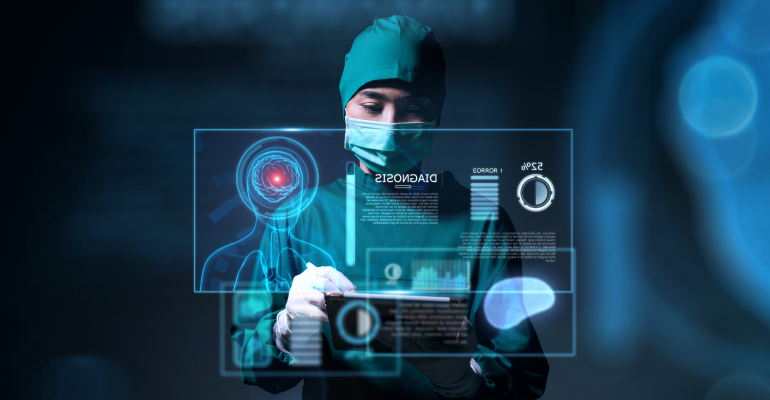Medical imaging is an indispensable tool in modern healthcare, enabling clinicians to visualise internal structures and diagnose a wide range of medical conditions. The integration of artificial intelligence (AI) into medical imaging has led to transformative advancements, enhancing the accuracy, efficiency, and overall quality of patient care. This article delves into the status of AI in medical imaging, its applications across various modalities, the challenges it faces, and the exciting possibilities it holds for the future.
Current applications of AI in medical imaging
Diagnosis and detection
One of the primary applications of AI in medical imaging is aiding in the diagnosis and detection of diseases. Deep learning algorithms, a subset of AI, have demonstrated remarkable capabilities in identifying subtle abnormalities within medical images. For example, AI has shown promising results in the early detection of diseases like cancer, enabling earlier intervention and improved patient outcomes. AI-powered algorithms can analyse large datasets of medical images with unparalleled speed, assisting radiologists in making more accurate diagnoses.
Image segmentation and analysis
Medical image segmentation, the process of identifying and delineating specific structures within an image, is essential for treatment planning and monitoring. AI algorithms can automate this process, leading to more precise measurements and assessments. In cardiology, AI-enabled segmentation techniques assist in measuring ventricular volumes and assessing heart function, while in neurology, they aid in the segmentation of brain tumours for treatment planning.
Personalised treatment
AI plays a crucial role in advancing personalised medicine. By analysing medical images along with patient data, AI algorithms can predict disease progression, suggest tailored treatment plans, and optimise therapy approaches based on an individual's unique characteristics. This personalised approach leads to more effective treatments and better patient outcomes.
Related: Predictive healthcare: How AI can save lives by detecting diseases earlier
Image enhancement and reconstruction
AI techniques can enhance the quality of medical images, improving the visibility of important structures and reducing artifacts caused by various factors such as motion or noise. AI algorithms can also reconstruct high-quality images from lower-quality inputs, which is particularly useful in scenarios where image acquisition might be limited.
Workflow optimisation
AI has the potential to streamline medical imaging workflows. Routine tasks, such as image acquisition, annotation, and reporting, can be automated, allowing medical professionals to focus on more complex tasks that require human expertise. This optimisation leads to increased efficiency and reduced workload.
Challenges and ethical considerations
While the integration of AI into medical imaging brings about numerous benefits, it also presents several challenges that need to be addressed:
Data quality and quantity
AI algorithms require large amounts of high-quality labelled data to train effectively. However, obtaining such datasets can be challenging in the medical field due to privacy concerns, data variability, and the need for expert annotations.
Interpretability and explainability
AI models, particularly deep learning models, often function as black boxes, making it challenging to understand the rationale behind their decisions. The lack of interpretability raises concerns among clinicians who need to trust and comprehend the AI-generated results.
Regulatory and ethical considerations
The deployment of AI in medical imaging necessitates careful adherence to regulatory standards and ethical guidelines. Rigorous validation and approval processes are essential to ensure patient safety and the reliability of AI-generated diagnoses.
Related: AI-powered growth in healthcare: early trends and learnings
Human-AI collaboration
Striking the right balance between AI and human expertise is crucial. Integrating AI into clinical workflows requires a harmonious collaboration between healthcare professionals and AI systems. The role of radiologists and clinicians evolves from being sole interpreters to collaborators who leverage AI insights.
The promising future of AI in medical imaging
The future of AI in medical imaging holds remarkable potential for further advancements and innovations:
Enhanced diagnosis and early intervention
As AI algorithms continue to evolve, they will become even more proficient at identifying subtle patterns and anomalies within medical images. This will lead to earlier and more accurate diagnoses, enabling timely interventions and potentially reducing the burden of advanced-stage diseases.
Multimodal integration
The integration of data from multiple imaging modalities, along with clinical and genomic data, will provide a holistic view of a patient's health. AI will play a pivotal role in synthesising and interpreting this multimodal data, allowing clinicians to make comprehensive and informed decisions.
Real-time decision support
Advancements in hardware and AI algorithms will enable real-time analysis of medical images during surgical procedures or interventions. Surgeons and interventional radiologists will have immediate access to critical information, enhancing precision and patient safety.
Continual learning and adaptation
AI models will likely become more adaptive, continually learning from new data and evolving disease patterns. This adaptability will enhance their diagnostic accuracy over time and improve their ability to handle emerging diseases.
Global accessibility to expertise
AI-powered tools can bridge the gap between regions with limited access to expert radiologists and specialised medical facilities. Remote diagnosis and telemedicine will be empowered by AI, providing quality healthcare to underserved populations.
Drug discovery and treatment development
AI can aid in drug discovery and development by analysing large datasets of medical images to identify potential targets and assess treatment efficacy. This accelerates the process of bringing new therapies to the market.
Conclusion
The integration of AI into medical imaging represents a paradigm shift in healthcare, enhancing diagnostic accuracy, personalised treatment, and overall patient care. While challenges related to data quality, interpretability, and ethics must be navigated, the future holds exciting prospects for AI in medical imaging. The collaborative relationship between AI and healthcare professionals will be pivotal in harnessing AI's potential to its fullest. As AI algorithms continue to evolve and adapt, they will undoubtedly play an integral role in shaping the future of medical imaging and healthcare.



